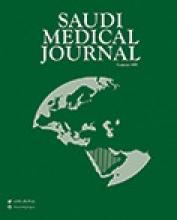Abstract
OBJECTIVE: Immune activation often associated with human immunodeficiency virus (HIV) infection is characterized by increasing number of peripheral blood T-lymphocytes expressing HLA-DR molecule. This study was performed to investigate the changes in the percentage of activated lymphocytes in the peripheral blood of HIV infected patients on antiretroviral therapy.
METHODS: Routine flow cytometry data for peripheral blood lymphocyte subsets were analyzed in 11 HIV infected hemophilia patients (mean age 27 +/- 7) at approximately 6 monthly intervals from 1996 to 2002 in the Division of Immunology, King Khalid University Hospital, Riyadh, Kingdom of Saudi Arabia. The number of data sets for each individual was variable, ranging between 5-13. Percentages of each lymphocyte subset were extracted and correlations were sort by using linear regression analysis.
RESULTS: Proportion of activated T-lymphocytes in the peripheral blood was initially high. Over a period of 2-5 years the percentage of T-lymphocytes, expressing HLA-DR molecule was found to have decreased significantly (P < / =0.0001) in all the patients most probably as a result of antiretroviral therapy. There was no statistically significant change in the proportion of any other lymphocyte subtype studied. The reduction in the percentage of HLA-DR+ T-lymphocyte population inversely correlated with CD4/CD8 ratios in 8 and for the CD4+ lymphocyte proportions with 5 out of 11 patients, whereas positive correlation for CD8+ lymphocyte proportions was noted in 4 patients.
CONCLUSION: These findings confirm immune activation in HIV infection with the increasing percentage of HLA-DR+ T-lymphocytes in the peripheral blood. Declining activated T-lymphocyte proportion in the peripheral blood and its inverse correlation with CD4/CD8 ratio may be more sensitive in detection of changes in CD4+ and CD8+ lymphocyte populations in HIV infection serving as a prognostic marker.
- Copyright: © Saudi Medical Journal
This is an open-access article distributed under the terms of the Creative Commons Attribution-Noncommercial-Share Alike 3.0 Unported, which permits unrestricted use, distribution, and reproduction in any medium, provided the original work is properly cited.






